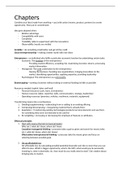Chapters
Combine your idea (made from anything + you) with action (money, product, partners) to create
opportunity. Then put in commitment.
Idea gets adopted when:
- Relative advantage
- Compatibility with users
- Complexity
- Trialability (able to experiment with the innovation)
- Observability (results are visible)
Scrabble = do something small better and get all the credit
Social entrepreneurship = making a better world with new ideas
Entrepreneur = an individual who fulfils a particular economic function by undertaking certain tasks
- Economic: The function of the entrepreneur
Providing market efficiency, accepting risk, maximizing investors returns, processing
market information
- Managerial: The tasks undertaken by the entrepreneur
Owning the business, founding new organizations, bringing innovations to the
market, identifying opportunities, applying expertise, providing leadership
- Psychological: The entrepreneur as a personality
Bootstrapping = starting a business without taking on external funding/as little as possible
Resources needed (capital, labor and land)
- Financial resources (cash, loans, investments)
- Human resources (labor, expertise, skills, communication, strategy, leadership)
- Operating resources (premises, vehicles, machinery, materials, equipment)
Transforming means into a real business
1. Deleting/supplementing = subtracting from or adding to an existing offering
2. Composing/decomposing = reorganizing material that is already there
3. Exaptation = Transforming existing technologies/products/services/elements and use them
for something they were not intended to be used for
4. Re-weighting = increasing or decreasing the emphasis of features or attributes
Effectual principles
1. Start with means (the bird-in-hand principle)
Who am I, what do I know, whom do I know
Causation/managerial thinking = processes take a goal as given and search for means (who
am I, what do I know, whom do I know)
Effectuation/entrepreneurial thinking = processes take the means given and focus on
selecting between possible goals
2. Set up affordable loss
Set affordable loss by calculating possible/potential downside and risk no more than you can
afford to lose. Which is bigger opportunity, what is the NPV, what would you be personally
investing in, what is downside, etc. How much do you really need to start? Get creative about
bringing idea to market.
, 3. Create great relationships/partnerships (crazy quilt)
Quilter determines the patterns, quilters work together with others, unlimited possibilities,
uncertain outcome, must be pleasing, valuable, meaningful, pleasing, etc.
4. Manage contingencies and leverage them (lemonade principle)
Can improve those odds by social networking, openness to experiences and opportunity
framing
5. Control or predict (pilot in the plane)
Prediction: When the future is predictable, we can use our knowledge of the past—of
common recurring patterns—to predict the future.
Risk: When the future is risky; we are dealing with an unknown distribution; but we know the
range, and the possibility of the values.
Uncertainty: We don’t know the distribution of possible scenarios, either we don’t know the
range of the possible outcomes.
Control and influence what you can, predict when it’s more useful than control
Exogenous = shaping environment
Endogenous = shaping yourself
Ownership
Ownership buys residual claims = claims to anything of value that remains after all contractual rights
and obligations have been fulfilled.
Equity can be used for: ownership of financial returns and attract potential partners.
Dilution protection:
1. First refusal = keep them at x-percentage of ownership
2. Ratchet = protects in event of down round (value of the firm drops over time) by maintaining
same ownership percentage
3. Liquidation preferences = major investors get paid first in a liquidity event
Term-sheet rule: whoever has the gold, makes the rules
Control: directors (ability to add person to board), information rights (internal statements), voting
rights (preferred votes)
Board can provide expertise (begin with board of advisors, later board of directors)
Is needed in all stages:
Seed: financial, legal and business development needed
Emerging management: industry expertise, market, financial, legal, management
Growth: same as emerging management + strategic
Mature: strategic, market, financial and management
Business plan = communication tool used for investors, stakeholders, management, partners,
suppliers, employees, etc. About sharing your mastery of the opportunity and how to deal with
things. Includes: revenue model, operating approach, people approach, differentiators, predictions
Boundary object = bridge across different professional worlds
Big companies contain 3 positive attributes: prediction, structure and process
Making company more market-like: autonomy, rewards and psychological safety




